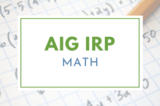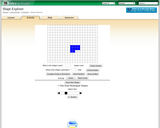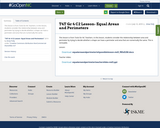
A fun and interactive game for students to practice their perimeter skills. This includes a game to play and task card to extend learning.
- Subject:
- Mathematics
- Material Type:
- Activity/Lab
- Date Added:
- 05/30/2020

A fun and interactive game for students to practice their perimeter skills. This includes a game to play and task card to extend learning.

A fun and interactive game for students to practice their perimeter skills.

Students will use mathematical and scientific tools to create a pictorial representation of their school grounds. Students will learn and use appropriate vocabulary for this task.

This 4 unit of measurement lessons explores area and perimeter through 4 hands-on activities and 2 worksheets.

In this lesson students calculate the areas of polygonal figures. They use hash marks to create square units and to count the units, including half-units.

Students apply historical information to math problems to gain an understanding of the flag's size. This activity is included in the online exhibition entitled The Star-Spangled Banner: The Flag that Inspired the National Anthem.

This 4 unit of number and operations lessons explores multi-digit multiplication through 14 hands-on activities and 9 worksheets.

In this activity, students will build on their understanding of finding areas of rectilinear figures in a real world context. This activity is appropriate for students who demonstrate a mastery of determining the area of rectangular figures as well as relating area to the operations of multiplication and division. The students will solve a problem involving unknown side lengths in a rectilinear figure. This lesson was developed by NCDPI as part of the Academically and/or Intellectually Gifted Instructional Resources Project. This lesson plan has been vetted at the state level for standards alignment, AIG focus, and content accuracy.

In this lesson, students will put their skills with area and perimeter to the test in order to plan out a school garden. They will solve problems to determine the length and width of a rectangle given a fixed area and varying perimeters, and a fixed perimeter and varying areas.

In this lesson, students identify the attributes of quadrilaterals, measure perimeter and area, and use formulas to calculate the area of quadrilaterals.

This course was created by the Rethink Education Content Development Team. This course is aligned to the NC Standards for 4th Grade Math.

This course was created by the Rethink Education Content Development Team. This course is aligned to the NC Standards for 4th Grade Math.

This online interactive allows students to demonstrate their abiltiy to calculate area and perimeter of a given figure. The interactive informs students if their answers are correct or not, as well as provides scores.

In this lesson, students explore the connection between area and perimeter using one inch tiles. The lesson is based on the book "Spaghetti and Meatballs for All," written by Marilyn Burns.

In this lesson, students explore the connection between area and perimeter using one inch tiles. The lesson is based on the book "Spaghetti and Meatballs for All," written by Marilyn Burns.

This short video and interactive assessment activity is designed to teach third graders an overview of area and perimeter.

Students analyze and begin to design a pyramid. Working in engineering teams, they perform calculations to determine the area of the pyramid base, stone block volumes, and the number of blocks required for their pyramid base. They make a scaled drawing of the pyramid using graph paper.

This lesson is from Tools for NC Teachers. In this lesson, students consider the relationship between area and perimeter by trying to decide whether a shape can have a perimeter and area that are numerically the same.

This is Tools for NC Teachers. In this lesson, students develop a deeper understanding of perimeter by solving and discussing perimeter problems involving rectangles with missing sides.

This lesson is from Tools for NC Teachers. In this lesson, students develop a deeper understanding of perimeter by solving and discussing perimeter problems involving rectangles with missing sides. This is remixable.